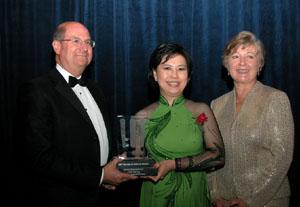 Dương Nguyệt Ánh đến Hoa Kỳ cùng với gia đình vào năm 1975, trong làn sóng tỵ nạn Cộng Sản đâu tiên, sau khi miền Nam Việt Nam thất thủ. Khi ấy cô mới 15 tuổi. Nguyệt Ánh vào học lớp 10 tại trường trung học địa phương ở tiểu bang Maryland, với vốn liếng vỏn vẹn chừng vài chục chữ Anh ngữ. Nhưng Nguyệt Ánh quyết tâm phải thành công vì tự ái dân tộc, vì cô không muốn ai khinh thường người tỵ nạn VN. Với ý chí đó, cô đã tốt nghiệp trung học, Kỹ Sư Hóa Học, Điện Toán và Cao Học Quốc Gia Hành Chánh, tất cả đều với hạng danh dự.
Dương Nguyệt Ánh đến Hoa Kỳ cùng với gia đình vào năm 1975, trong làn sóng tỵ nạn Cộng Sản đâu tiên, sau khi miền Nam Việt Nam thất thủ. Khi ấy cô mới 15 tuổi. Nguyệt Ánh vào học lớp 10 tại trường trung học địa phương ở tiểu bang Maryland, với vốn liếng vỏn vẹn chừng vài chục chữ Anh ngữ. Nhưng Nguyệt Ánh quyết tâm phải thành công vì tự ái dân tộc, vì cô không muốn ai khinh thường người tỵ nạn VN. Với ý chí đó, cô đã tốt nghiệp trung học, Kỹ Sư Hóa Học, Điện Toán và Cao Học Quốc Gia Hành Chánh, tất cả đều với hạng danh dự.
Vì lớn lên trong chiến tranh, bà Nguyệt Ánh rất quý và thương chiến sĩ. Bà luôn tri ân chiến sĩ Việt Nam Cộng Hòa đã bảo vệ cho Bà được sống bình an và tự do trong suốt 15 năm ở quê nhà; và chiến sĩ Hoa Kỳ ngày nay đang tiếp tục bảo vệ cho Bà và gia đình được sống bình an, tự do ở quê hương mới. Do đó, Bà đã chọn làm việc cho Quốc Phòng để có dịp trả ơn chiến sĩ và góp phần vào nghĩa vụ bảo vệ nền dân chủ tự do cho Hoa Kỳ.
Cho đến nay, Bà Dương Nguyệt Ánh đã đóng góp hơn 24 năm cho Khoa Học và Kỹ Thuật Quốc Phòng. Bà là một trong những chuyên gia chất nổ hàng đầu của Hoa Kỳ, với danh tiếng ở tầm vóc quốc tế. Trong thập niên 90, Bà từng lãnh đạo toàn bộ chương trình nghiên cứu và chế tạo chất nổ của Hải Quân, và đã đem lại 10 chất nổ mới cho 18 loại vũ khí được trang bị cho Hải, Lục, Không Quân và Thủy Quân Lục Chiến Hoa Kỳ. Do thành tích kỷ lục này, Khoa học gia Dương Nguyệt Ánh được Hải Quân trao tặng giải thưởng cao quý Dr. Arthur Bisson Award for Naval Technology Achievement vào năm 2000. bà cũng từng là Đại Biểu của Hoa Kỳ tại Liên Minh Phòng Thủ Bắc Đại Tây Dương (Tiểu Ban Chất Nổ), là tác giả của nhiều bài viết nghiên cứu về chất nổ và đã từng thuyết trình ở rất nhiều hội nghị chuyên môn quốc tế và quốc nội.
Khoa học gia Dương Nguyệt Ánh đươc nhiều người biết đến qua thành quả chế tạo bom Áp Nhiệt cho chiến trương A Phú Hãn. Vào tháng 11 năm 2001, hai tháng sau biến cố 9/11, Bà nhận được yêu cầu giúp chế tạo gấp một loại vũ khí mới có khả năng hủy diệt hang động nơi quân khủng bố thường trú ẩn, để tránh tổn thất nặng nề cho binh sĩ Hoa Kỳ trong những cuộc tảo thanh. Ba đã gấp rút thành lập và lãnh đạo một toán gồm hơn 100 khoa hoc gia, kỹ sư và chuyên gia và đã đi từ khái niệm, thực hiện, đến thử nghiệm và chế tạo thành công một loại vũ khí mới này, gọi là bom Áp Nhiệt. Tất cả chỉ trong một thời gian kỷ lục 67 ngày!
Để vinh danh sự thành công rực rỡ này, Bộ Trưởng Hải Quân đã gắn huy chương Military Commendation Unit cho Trung Tâm Nghiên Cứu và Chế Tạo vũ khí Hải Quân nơi Bà Nguyệt Ánh làm việc, toán khoa học gia dưới quyền Bà được giải Roger Smith Team Award và riêng Bà Nguyệt Ánh được trang trọng gắn huy chương Civilian Meritorious Medal.
Năm 2002, Khoa học gia Dương Nguyệt Ánh được bổ nhiệm vào chức vụ Tổng Giám Đốc Khoa Học và Kỹ Thuật của Trung Tâm Nghiên Cứu và Chế Tạo Vũ Khí Hải Quân ở Maryland. Ở chức vụ này, Bà là người định huớng và điều khiển tất cả các chương trình nghiên cứu trên mọi lãnh vực khoa học và kỹ thuật của trung tâm này, với mục đích áp dụng vào việc chế tạo những thế hệ vũ khí tương lai cho Hoa Kỳ.
Kể từ tháng 11 năm 2006 cho đến nay, Bà Nguyệt Ánh về làm cho Ngũ giác Đài và hiện đảm nhận chức vụ Cố Vấn Khoa Học Kỹ Thuật cho Phó Đô Đốc John Morgan, Tư Lệnh Phó Hải Quân Đặc trách về Kế Hoạch và Chiến Lược, và cho Tổng Giám Đốc Thomas Betro, Chỉ huy trưởng Cơ Quan Điều Tra Tội Phạm và Phản Gián của Hải Quân. Ở chức vụ hiện tại, Nguyệt Ánh hoàn toàn chú tâm vào chiến tranh chống khủng bố, kể cả việc áp dụng khoa học kỹ thuật của tình báo, phản gián và điều tra tội phạm vào công tác chiến trường, và các sứ mạng chống khủng bố toàn cầu.
Khả năng lãnh đạo và tinh thần phục vụ quốc gia của KHG Dương Nguyệt Ánh được biết đến rất nhiều. Năm 2004, Bà được vinh danh với giải thưởng Award of Excellence for Public Service bởi U.S. Pan Asian American Chamber of Commerce.
Bà từng xuất hiện trên nhiều tờ báo và tạp chí lớn, như The Washington Post, The Sun, Asian Week, v.v… và các đài truyền thanh, truyền hình như BBC London, Voice of America, SBTN, v.v… Bà cũng được mời trình bày quan điểm của mình về chiến tranh trong cuốn phim tài liệu đoạt giải thưởng Sundance Film Festival tựa đề là Why We Fight, và là một trong những nhân vật được đề cao trong cuốn sách mới xuất bản của the American Society of Civil Engineers năm 2006, tựa đề la “Thay Đổi Thế Giới Của Chúng Ta: Những Câu Chuyện Thật về những Nữ Kỹ Sư (Changing Our World: True Stories of Women Engineers). Tháng 3 năm 2006, Bà được Bộ Chỉ Huy Hải Quân Mặt Biển (Naval Sea Systems Command) dàn chào để vinh danh Bà, nhân dịp tháng 3 là tháng của lịch sử phụ nữ Hoa Kỳ.
Gần đây nhất, đài truyền hình Discovery và Military Channel đã cho trình chiếu thành quả khoa học của vũ khí Áp Nhiệt và tường thuật về KHG Dương Nguyệt Ánh trong loạt phim tài liệu về những bộ óc đàng sau những vũ khí tương lai của thế giới (“Future Weapons”).
Tháng 6 năm 2007 vừa qua, KHG Dương Nguyệt Ánh là một trong 4 nhân vật vào chung kết cho huy chương toàn quốc Service to America Medal for National Security (Huy Chương Phục Vụ Quốc Gia về An Ninh) và đã đươc vinh danh trong một buổi lễ tổ chức ở quốc hội Hoa Kỳ. Mới đây, Bà vừa được thông báo sẽ là người đoạt huy chương cao quý này và buổi lễ gắn huy chương cho Bà, tổ chức ở Hoa Thịnh Dốn.
 Duong Nguyet Anh Biography
Duong Nguyet Anh Biography
During the invasion of South Vietnam by the North Vietnamese Army and their Viet Cong allies, she and her family left their homeland, while the Army of the Republic of Vietnam (ARVN) were defending the capital city of Saigon.
Her family were devout anti-communists. To escape communism, they left Vietnam by boat and sailed to the Philippines. They were assigned to a refugee camp. Her family then contacted the U.S. Embassy and were given political asylum in the United States.
She graduated from the University of Maryland with both a B.S. degree in Chemical Engineering and a B.S. degree in Computer Science.
In 1983 she started working as a Chemical Engineer at the Indian Head Naval Surface Weapons Center.
From 1991-1999, she managed all Navy basic, exploratory research and advanced development programs in High Explosives. Served as the U.S. Navy focus point for explosives and the transition of Navy explosives into weapon systems, providing consultation to government/military, industries and allied nations.
From 1999-2002, she managed all NSWC Indian Head’s technical programs in Explosives and Undersea Weapons, from concept through engineering development to production and demilitarization.
She successfully assembled and led a team of scientists and engineers to develop the payload for a new weapon, now known as the thermobaric bomb, then proceeded to limited production and delivery to the Air Force, all in an unprecedented period of 67 days.
Nguyet Anh successfully led the development and transition of a total of 10 high performing explosives into 18 different U.S. weapons in the past 12 years, which is an unprecedented record of its kind.
She served as a U.S. Delegate at the NATO AC310 Subgroup I for Explosives, and chairman/member of many national and international Panels/Technical Steering Groups.
Since 2002 Nguyet Anh has been Director of Science and Technology of Naval Surface Warfare Center, U.S. Department of Defense, where she is responsible for Indian Head’s overall technical investment strategies, guiding and overseeing research and development programs in all areas of science and technology and focusing these efforts toward the creation of future weapon generations for the United States.
Awards
In 1999 she was awarded the Dr. Arthur E. Bisson Prize for Achievement in Naval Technology and had her name engraved in a plaque on permanent display at the Office of Naval Research.
In 2001, she was awarded the Civilian Meritorious Medal for superb leadership, technical expertise and significant contributions to the Department of Defense in the area of High Performance Explosives.
In 2007, she was awarded the National Security Medal for significant contribution to the nation in activities related to national security.
Việt Thức [Tin tổng hợp]











































One Comment
Dzung Nguyen
To be clear about the development of:BLU-118/B Thermobaric Weapon
The BLU-118/B nomenclature was first reported on 21 December 2001, and this weapon is clearly unrelated to the BLU-118 500 lb. napalm canister used during the Vietnam war.
The BLU-118/B is a penetrating warhead filled with an advanced thermobaric explosive that, when detonated, generates higher sustained blast pressures in confined spaces such as tunnels and underground facilities. The BLU-118/B uses the same penetrator body as the standard BLU-109 weapon. The significant difference is the replacement of the high explosive fill with a new thermobaric explosive that provides increased lethality in confined spaces.
The BLU-118/B warhead uses a Fuze Munition Unit (FMU)-143J/B to initiate the explosive. The FMU-143 fuze has been modified with a new booster and a 120-millisecond delay. All weapon guidance systems and employment options currently used with the BLU-109 warhead are compatible with the new BLU-118/B warhead.
BLU-118/B payload candidates included PBXIH-135 [one of the Navy’s new insensitive polymer bonded explosives], HAS-13, or SFAE [solid fuel air explosive] loaded into existing BLU-109 Weapon Bodies. Conventional high explosives (CHE) are characterized by a sensitivity to mechanical or thermal energy. Insensitive high explosives (IHE), on the other hand, require extraordinarily high stimuli before violent reaction occurs. Insensitive explosives reliably fulfil their performance, readiness and operational requirements on demand, but the violence of response to unplanned hazardous stimuli is restricted to an acceptable level. This means that when a munition is in a fire, hit by a fragment, bullet or high velocity projectile or subject to some other hazard the result will not be a detonation or a violent reaction of the explosive and propellant; no more than severe burning will ocur [such a deflagration is an exothermic reaction that occurs particle to particle at subsonic speed]. Some insensitive explosives are known to react in a different way to conventional explosives. For instance, detonation reactions are slower but more energy is released in a way that has the potential to produce a lot more damage.
The BLU-118/B bomb body can be attached to a variety of laser guidance system packages, including the GBU-15, GBU-24, GBU-27, and GBU-28 laser guided bombs, as well as the AGM-130 missiles.
BLU-118B weapon operational concepts include vertical delivery with the bomb detonated at or just outside portal, skip bomb with short fuse (1st or second contact), skip bomb with long fuse (penetrate door, max distance down adit), and vertical delivery to penetrate overburden and detonate inside the tunnel adit.
In October 2001 the Department of Defense accelerated a number of programs being pursued as Advanced Concept Technology Demonstrations (ACTD) that could be used in Operation Enduring Freedom in Afghanistan. The Defense Threat Reduction Agency (DTRA) organized a quick-response team on October 11, 2001, that included Navy, Air Force, Department of Energy and industry experts to identify, test, integrate and field a rapid solution that would enhance weapons options in countering hardened underground targets.
Explosive experts at the Naval Surface Weapons Center, Indian Head, MD, responded with a developmental explosive that provided enhanced internal blast effects. The Air Force Precision Strike Program Office at Eglin AFB, FL, led the team performing the weapon system integration, safety and flight clearances, and produced a modified fuzing system for the new warhead. The Indian Head facility conducted static testing of the fuze to demonstrate reliable initiation of the new explosive. Indian Head experts were called upon to provide the energetic solution, as PBXIH-135 was selected as the thermobaric bomb fill for the Air Force BLU-109 bombs. This new thermobaric bomb, designated as BLU-118/B, was developed within 67 days and subsequently supported Operation Enduring Freedom. Both static and flight tests were then conducted at full-scale tunnel facilities at the Nevada Test Site.
The BLU-118B was successfully tested at the Nevada Test Site on 14 December 2001. During that test, a Guided Bomb Unit (GBU)-24 laser-guided weapon using the BLU-118B warhead was dropped from an F-15E attack aircraft. The laser-guided bomb was “skipped” into a tunnel and exploded with a delayed fuze, which produced a significant growth in overpressure and temperature in the tunnel. When compared to the standard BLU-109 explosive, results showed the new thermobaric weapon generated a significant improvement in overpressure and pressure-impulse in the tunnel complex. The test culminated a two-month accelerated effort to rapidly transition a developmental explosive to improve lethality against underground facilities. DTRA weaponized and delivered (within 60 days) 10 thermobaric-filled air delivered munitions (BLU-118B) designed to enhance lethality in tunnel environments.
On 21 December 2001 Undersecretary of Defense for Acquisition Edward C. Aldridge officially announced that a small number of the weapons were being deployed to attack tunnels in Afghanistan. As of late January 2002, the Air Force had completed verification and validation of the technical data and operational flight clearances needed to deploy the BLU-118B warhead. Ten warheads were, as a result, immediately made available to the U.S. Air Force for deployment. These are compatible with the GBU-15, GBU-24, and Air-launched Surface-attack Guided Missile (AGM)-130 weapon systems for employment by U.S. Air Force F-15E Strike Eagle aircraft.
On or about Sunday 03 March 2002 a single 2,000-pound thermobaric bomb was used for the first time in combat against cave complexes in which al-Qaeda and Taliban fighters had taken refuge in the Gardez region of Afghanistan.
Regards,
DN